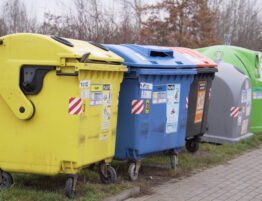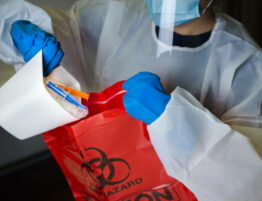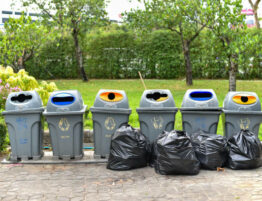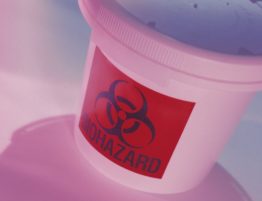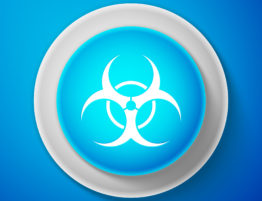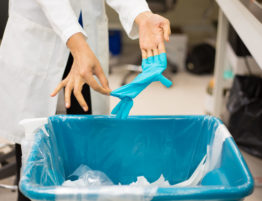
Biomedical waste is essential for environmental sustainability and healthcare management, although it is frequently ignored in popular discourse. It includes a broad range of materials produced during medical treatments, research projects, and regular business operations of healthcare facilities. Comprehending the examples of biomedical waste is vital for executing efficacious waste management tactics, ensuring public health protection, and conserving the environment.
Types of Biomedical Waste
- Infectious Waste
Materials infected by pathogens, such as bacteria, viruses, fungi, and parasites, are classified as infectious waste. Bandages, gloves that have been thrown away, cultures, and leftovers from medical procedures are a few examples. If these things are not handled and disposed of appropriately, there is a significant chance that illnesses will spread.
- Sharps Waste
Sharps are lancets, scalpels, syringes, and needles that can cut or puncture someone. Sharps disposal errors can result in cuts and the spread of bloodborne infections such as hepatitis B, hepatitis C, and HIV. To safeguard healthcare personnel, waste handlers, and the public, healthcare facilities must ensure that sharps waste is safely contained and disposed of.
- Pathological Waste
Human or animal tissues, organs, and body parts removed during operations, autopsies, or medical tests are considered pathological waste. Fetuses, results of conception, and anatomical specimens are also included in this category. When handling human remains, proper disposal techniques such as chemical treatment or incineration are required to stop the spread of illness and preserve dignity.
- Pharmaceutical Waste
Unused medications, expired or contaminated, empty medicine vials, ampules, and IV bags are all considered pharmaceutical waste. Pharmaceuticals not disposed of properly can pollute the environment, endanger human health, and affect aquatic life. Adopting disposal policies and pharmaceutical take-back programs helps reduce these hazards and guarantees appropriate medication administration.
- Chemical Waste
Chemical waste is made up of various dangerous materials utilized in medical environments, including solvents, disinfectants, chemotherapeutic agents, and laboratory reagents. Certain chemicals can potentially be toxic, explosive, or corrosive and must be handled and disposed of carefully to avoid harming the environment or human health.
- Radioactive Waste
Radioactive waste comes from treatments and diagnostic processes that use radioactive materials, like radiation therapy, nuclear medicine, and the manufacturing of radiopharmaceuticals. Proper shielding, storage, and disposal are crucial to reduce the risk of radiation exposure and stop the environment and nearby towns from becoming contaminated.
- Genotoxic Waste
Materials that can harm DNA or cause genetic alterations, such as some chemotherapeutic medications and cytotoxic chemicals, are included in genotoxic waste. There are significant health concerns associated with genotoxic agent exposure, such as carcinogenesis and reproductive damage. Strict safety protocols and specialized disposal techniques are required to safeguard the environment and healthcare personnel from these dangerous substances.
- Laboratory Waste
A wide variety of materials produced during scientific research, diagnostic testing, and experimental processes are included in the category of laboratory waste. Examples include contaminated glassware, culture plates, chemical containers, and animal carcasses. Safe laboratory waste management and the avoidance of contamination problems depend on appropriate segregation, labelling, and disposal procedures.
Like Examples of Biomedical Waste, You may also like to read about Example of Regular Medical Waste.
Implications of Biomedical Waste Management
Negligent handling of biomedical waste can significantly affect environmental integrity, public health, and regulatory compliance. Among the most critical ramifications are:
- Transmission of Infections
Patients, healthcare personnel, waste handlers, and the general public can all contract infections due to improper treatment and disposal of infectious waste. Biomedical waste contains pathogens that might cause severe infection if proper containment and treatment protocols are not followed.
- Occupational Hazards
Handling biological waste exposes waste management staff and healthcare workers to risks such as needlestick injuries, exposure to dangerous chemicals, and respiratory problems. To reduce these hazards, it is crucial to implement thorough training programs, offer personal protective equipment (PPE), and follow safety procedures.
- Environmental Contamination
Biomedical waste should not be disposed of carelessly as this can contaminate the air, water, and land and hurt human populations and ecosystems. Biomedical waste contains chemicals, medications, and radioactive materials that can linger in the environment and endanger public health and biodiversity over time.
- Regulatory and Legal Non-Compliance
Healthcare facilities and waste management organizations risk fines, legal repercussions, and reputational harm if they disregard local, national, and international laws governing the handling of biomedical waste. Waste segregation, treatment, and disposal rules must be followed to comply with legal requirements and preserve ethical standards.
Conclusion
Various materials produced in medical settings, research labs, and diagnostic centres are examples of biomedical waste. Each category presents threats and problems to public health and environmental sustainability, ranging from infectious trash and sharps to pharmaceuticals and radioactive items. To reduce these dangers and guarantee the safe and responsible handling of biomedical waste, it is imperative to use efficient waste management methods, such as segregation, containment, treatment, and disposal. To protect human health and the environment, stakeholders can work toward a future where biomedical waste is managed sustainably and ethically by increasing awareness, encouraging collaboration, and prioritising regulatory compliance.



